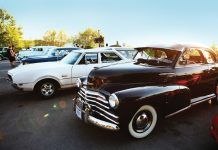
It was only the first week in July but the desert heat had already hit 90 degrees by 8 a.m. outside the Golden Acorn casino in Campo Wednesday.
About 100 people, mostly young to middle-aged adults stood in a large circle, listening as Bobby Wallace, a member of the Barona Band of Mission Indians Kumeyaay Nation and a Lakeside resident, led the group in discussion and a prayer before departing for the site where a portion of the Trump Administration’s border wall is being built, possibly on top of ancient Kumeyaay remains.
“We’re trying to stop these guys from decimating our people’s graveyards and our people’s belongings. This destruction is going on everywhere,” Wallace said.
While a bundle of smoldering sage made its way around the gathering, La Posta tribal member Cyn Parada joined Wallace at the center of the circle.
It was the second time in one week that Parada had reached out to the community to ask for help holding off the Army Corps of Engineers from moving forward with demolition on a site she says falls on untreatied territory that is potentially ripe with unfound artifacts.
According to Parada, Kumeyaay ancient natives left remains all over the area near where the border wall is slated for construction.
“Our people lived here thousands and thousands of years before it was a reservation. It is also Kumeyaay land. We had someone from Kumeyaay Community College find what he believes is a shoulder bone,” Parada said.
The 27 year old elected tribal council member said the potentially significant find turned up on Monday, before the United States Border Patrol released a statement later that day stating they had the whole area surveyed and found nothing.
“Based on prior environmental surveys and stakeholder coordination completed, no biological, cultural, or historical sites were identified within the blasting area located within the Roosevelt Reservation,” states the June 29 release from Border Patrol Public Affairs Officer Justin Castrejon.
“We’re asking for three things: one, soil testing for bones; two, monitors who are trained to spot native items; three, to have no more work done until the first two things are in place,” Parada said.
After the group drove to the nearby site, they encountered a chained gate blocking the private road, guarded by Border Patrol officers who were joined about 10 minutes later by Army Corps of Engineers workers.
Angela Elliott-Santos is Chairwoman for the Manzanita Band of the Kumeyaay Nation; she rose to the front of the group and asked Army Corps of Engineers worker Darrell Williams if he was able to contact a supervisor to determine whether a trained environmental monitor was on site as stated in the June 29 public affairs release Castrejon.
“I’m asking you today as the Manzanita chairwoman, is there a monitor out there on site today? There are plenty of ways to keep us informed ahead of time— is the law being upheld?” asked Elliott-Santos.
Williams claimed he could not contact a supervisor; Wallace bought the group a little time to pray while giving authorities time to produce an environmental monitor.
“We’d like to go out and be with our ancestors, practice the Religious Freedoms Act. We know you might have a little apprehension but we want to go out there and hold a peaceful prayer with our ancestors,” Wallace said.
The tribal leaders negotiated three hours to pray on site, ostensibly enough time for the Corps to contact supervisors and determine details of environmental monitoring being done on site.
Manzanita tribal member Brooke Baines later said in a follow up call that the fight is not about the wall itself.
“I want to make sure that it is made very clear that our point is not about the wall, it is about the execution of the wall. We’re not asking for the wall to be abolished, and we’re not saying we won’t ask for that in the future. It’s about having respect for the land, the ancestors and the history that it holds,” Baines said.
If remains are found on site, she says the ideal outcome would be to relocate and rebury human remains, and place any found artifacts in a museum if the entire site cannot be protected.
After the morning’s prayer session, Parada said she still had not received confirmation of an environmental monitor being present on site.













